Accounting Annual Report of Company
VerifiedAdded on 2020/04/21
|17
|2900
|32
AI Summary
Contribute Materials
Your contribution can guide someone’s learning journey. Share your
documents today.
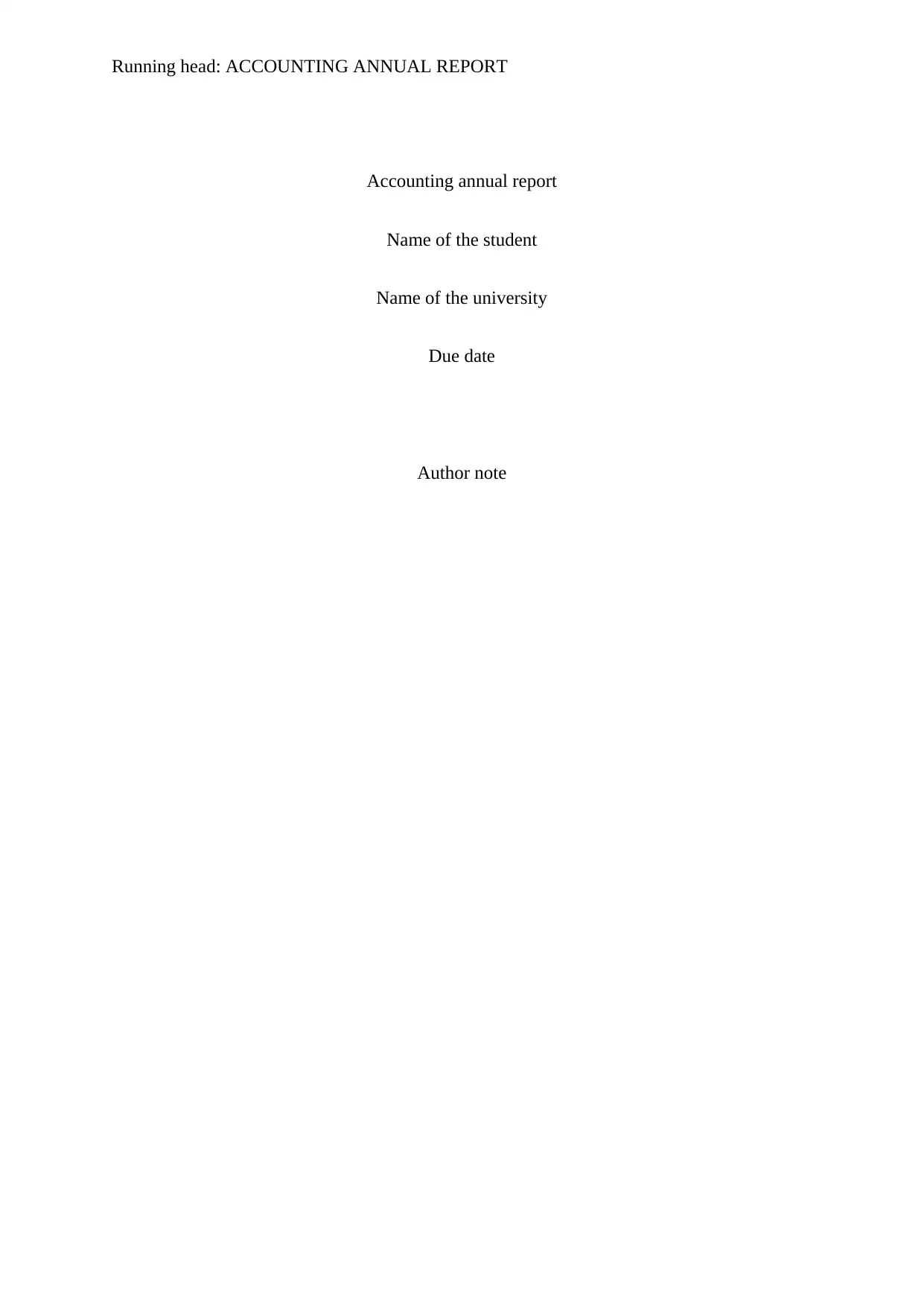
Running head: ACCOUNTING ANNUAL REPORT
Accounting annual report
Name of the student
Name of the university
Due date
Author note
Accounting annual report
Name of the student
Name of the university
Due date
Author note
Secure Best Marks with AI Grader
Need help grading? Try our AI Grader for instant feedback on your assignments.
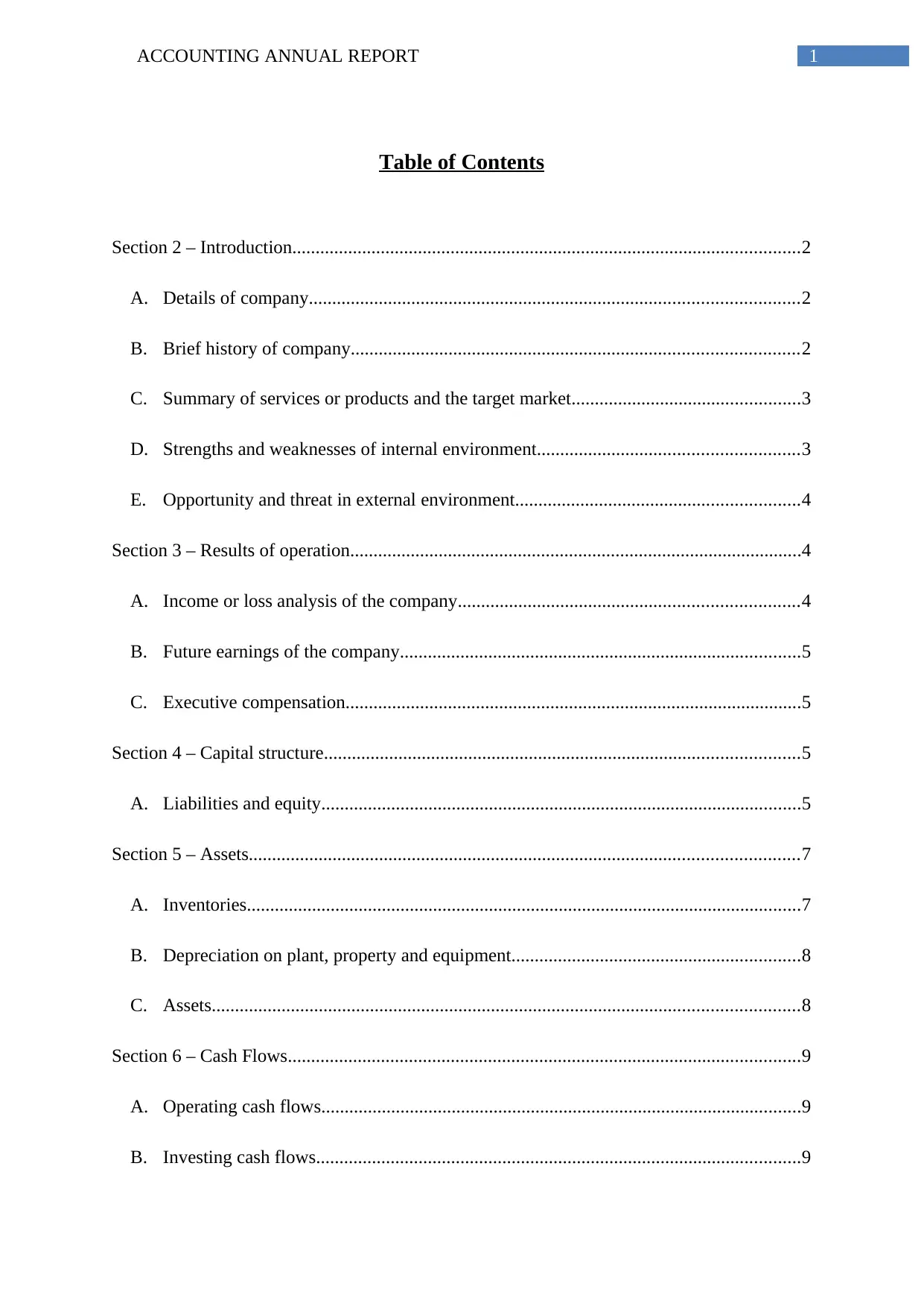
1ACCOUNTING ANNUAL REPORT
Table of Contents
Section 2 – Introduction.............................................................................................................2
A. Details of company.........................................................................................................2
B. Brief history of company................................................................................................2
C. Summary of services or products and the target market.................................................3
D. Strengths and weaknesses of internal environment........................................................3
E. Opportunity and threat in external environment.............................................................4
Section 3 – Results of operation.................................................................................................4
A. Income or loss analysis of the company.........................................................................4
B. Future earnings of the company......................................................................................5
C. Executive compensation..................................................................................................5
Section 4 – Capital structure......................................................................................................5
A. Liabilities and equity.......................................................................................................5
Section 5 – Assets......................................................................................................................7
A. Inventories.......................................................................................................................7
B. Depreciation on plant, property and equipment..............................................................8
C. Assets..............................................................................................................................8
Section 6 – Cash Flows..............................................................................................................9
A. Operating cash flows.......................................................................................................9
B. Investing cash flows........................................................................................................9
Table of Contents
Section 2 – Introduction.............................................................................................................2
A. Details of company.........................................................................................................2
B. Brief history of company................................................................................................2
C. Summary of services or products and the target market.................................................3
D. Strengths and weaknesses of internal environment........................................................3
E. Opportunity and threat in external environment.............................................................4
Section 3 – Results of operation.................................................................................................4
A. Income or loss analysis of the company.........................................................................4
B. Future earnings of the company......................................................................................5
C. Executive compensation..................................................................................................5
Section 4 – Capital structure......................................................................................................5
A. Liabilities and equity.......................................................................................................5
Section 5 – Assets......................................................................................................................7
A. Inventories.......................................................................................................................7
B. Depreciation on plant, property and equipment..............................................................8
C. Assets..............................................................................................................................8
Section 6 – Cash Flows..............................................................................................................9
A. Operating cash flows.......................................................................................................9
B. Investing cash flows........................................................................................................9
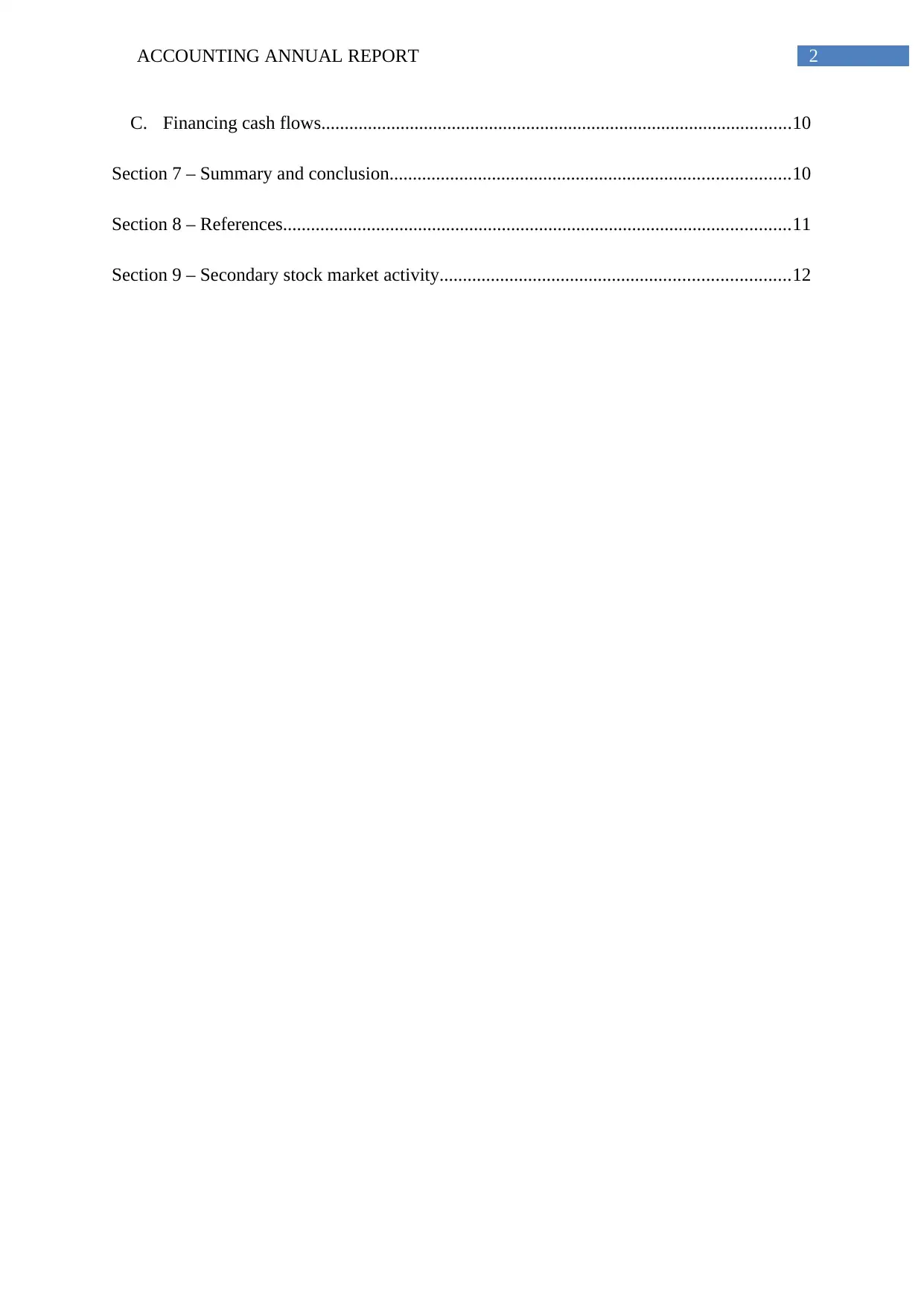
2ACCOUNTING ANNUAL REPORT
C. Financing cash flows.....................................................................................................10
Section 7 – Summary and conclusion......................................................................................10
Section 8 – References.............................................................................................................11
Section 9 – Secondary stock market activity...........................................................................12
C. Financing cash flows.....................................................................................................10
Section 7 – Summary and conclusion......................................................................................10
Section 8 – References.............................................................................................................11
Section 9 – Secondary stock market activity...........................................................................12

3ACCOUNTING ANNUAL REPORT
Apple Inc
Section 2 – Introduction
A. Details of company
Company name – Apple Inc
Industry – marketing, designing and manufacturing mobile communication, personal
computers, media devices and the portable digital music players
Internet address – http://www.apple.com
SIC code – Telecommunication Equipment Industry (3351), Electronic computers
(2630)
Major services or products – major services and the products of the company include
iPhone, Mac, iPad, iPod, Apple TV, consumer portfolio and applications for
professional software, Mac OS X operating system, iOS, iCloud and wide range of
services, accessories and support offerings.
Names of competitor – Samsung, Microsoft
Name of stock exchange - NASDAQ
Ticker symbol - APPL
Name of outside auditors – Ernst & Young
B. Brief history of company
Apple Inc is the American corporation involved in manufacturing and designing of
the computer software, hardware and various other electronic goods for consumers. The
company has it’s headquarter in Cupertino, California. The CEO and the co-founder of the
company is Steve Jobs and it boasts 284 retail locations over 10 countries. The company was
founded on 1st April, 1976 by Steve Jobs, Ronald Wayne and Steve Wozniak for selling
Apple Inc
Section 2 – Introduction
A. Details of company
Company name – Apple Inc
Industry – marketing, designing and manufacturing mobile communication, personal
computers, media devices and the portable digital music players
Internet address – http://www.apple.com
SIC code – Telecommunication Equipment Industry (3351), Electronic computers
(2630)
Major services or products – major services and the products of the company include
iPhone, Mac, iPad, iPod, Apple TV, consumer portfolio and applications for
professional software, Mac OS X operating system, iOS, iCloud and wide range of
services, accessories and support offerings.
Names of competitor – Samsung, Microsoft
Name of stock exchange - NASDAQ
Ticker symbol - APPL
Name of outside auditors – Ernst & Young
B. Brief history of company
Apple Inc is the American corporation involved in manufacturing and designing of
the computer software, hardware and various other electronic goods for consumers. The
company has it’s headquarter in Cupertino, California. The CEO and the co-founder of the
company is Steve Jobs and it boasts 284 retail locations over 10 countries. The company was
founded on 1st April, 1976 by Steve Jobs, Ronald Wayne and Steve Wozniak for selling
Secure Best Marks with AI Grader
Need help grading? Try our AI Grader for instant feedback on your assignments.
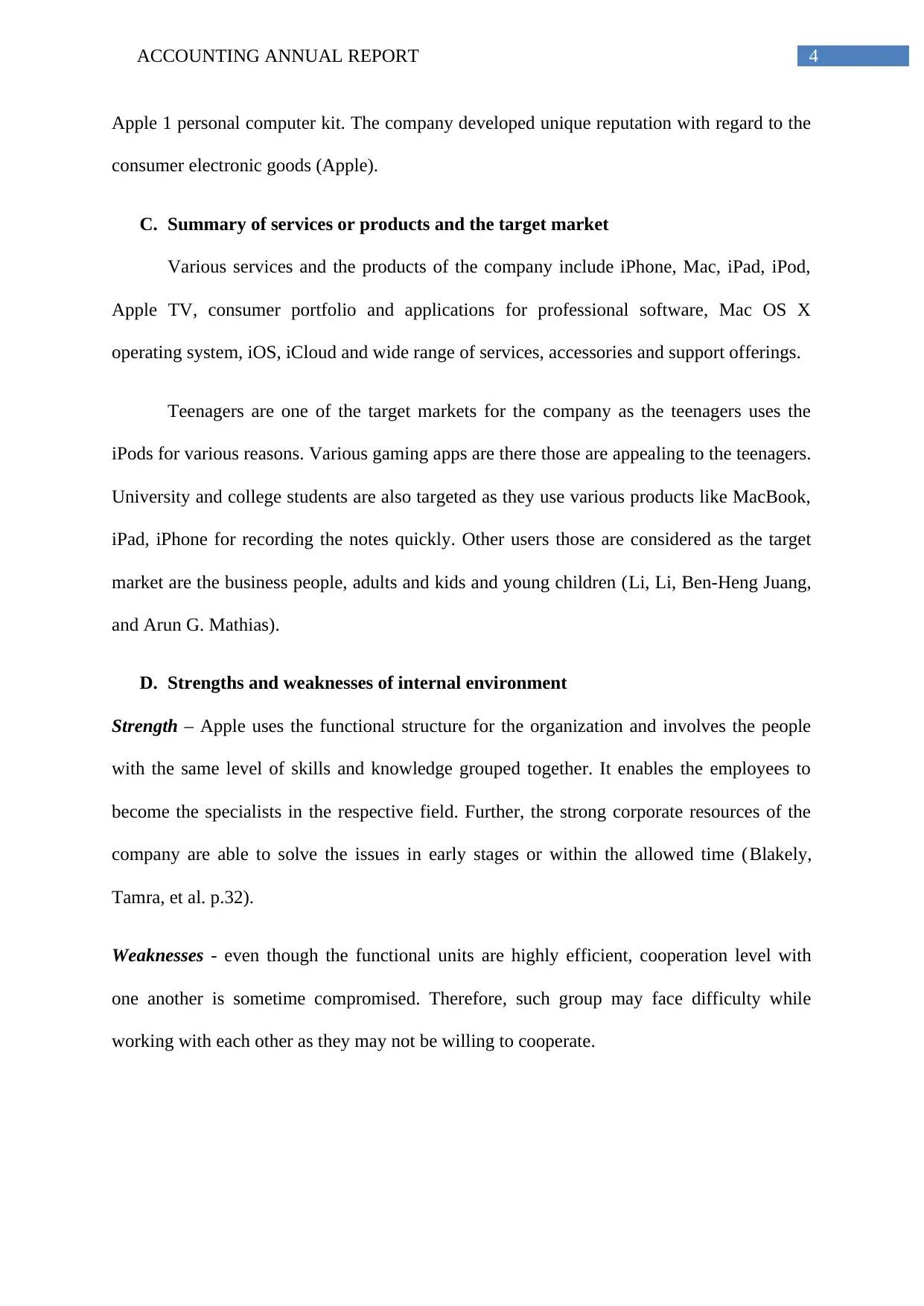
4ACCOUNTING ANNUAL REPORT
Apple 1 personal computer kit. The company developed unique reputation with regard to the
consumer electronic goods (Apple).
C. Summary of services or products and the target market
Various services and the products of the company include iPhone, Mac, iPad, iPod,
Apple TV, consumer portfolio and applications for professional software, Mac OS X
operating system, iOS, iCloud and wide range of services, accessories and support offerings.
Teenagers are one of the target markets for the company as the teenagers uses the
iPods for various reasons. Various gaming apps are there those are appealing to the teenagers.
University and college students are also targeted as they use various products like MacBook,
iPad, iPhone for recording the notes quickly. Other users those are considered as the target
market are the business people, adults and kids and young children (Li, Li, Ben-Heng Juang,
and Arun G. Mathias).
D. Strengths and weaknesses of internal environment
Strength – Apple uses the functional structure for the organization and involves the people
with the same level of skills and knowledge grouped together. It enables the employees to
become the specialists in the respective field. Further, the strong corporate resources of the
company are able to solve the issues in early stages or within the allowed time (Blakely,
Tamra, et al. p.32).
Weaknesses - even though the functional units are highly efficient, cooperation level with
one another is sometime compromised. Therefore, such group may face difficulty while
working with each other as they may not be willing to cooperate.
Apple 1 personal computer kit. The company developed unique reputation with regard to the
consumer electronic goods (Apple).
C. Summary of services or products and the target market
Various services and the products of the company include iPhone, Mac, iPad, iPod,
Apple TV, consumer portfolio and applications for professional software, Mac OS X
operating system, iOS, iCloud and wide range of services, accessories and support offerings.
Teenagers are one of the target markets for the company as the teenagers uses the
iPods for various reasons. Various gaming apps are there those are appealing to the teenagers.
University and college students are also targeted as they use various products like MacBook,
iPad, iPhone for recording the notes quickly. Other users those are considered as the target
market are the business people, adults and kids and young children (Li, Li, Ben-Heng Juang,
and Arun G. Mathias).
D. Strengths and weaknesses of internal environment
Strength – Apple uses the functional structure for the organization and involves the people
with the same level of skills and knowledge grouped together. It enables the employees to
become the specialists in the respective field. Further, the strong corporate resources of the
company are able to solve the issues in early stages or within the allowed time (Blakely,
Tamra, et al. p.32).
Weaknesses - even though the functional units are highly efficient, cooperation level with
one another is sometime compromised. Therefore, such group may face difficulty while
working with each other as they may not be willing to cooperate.
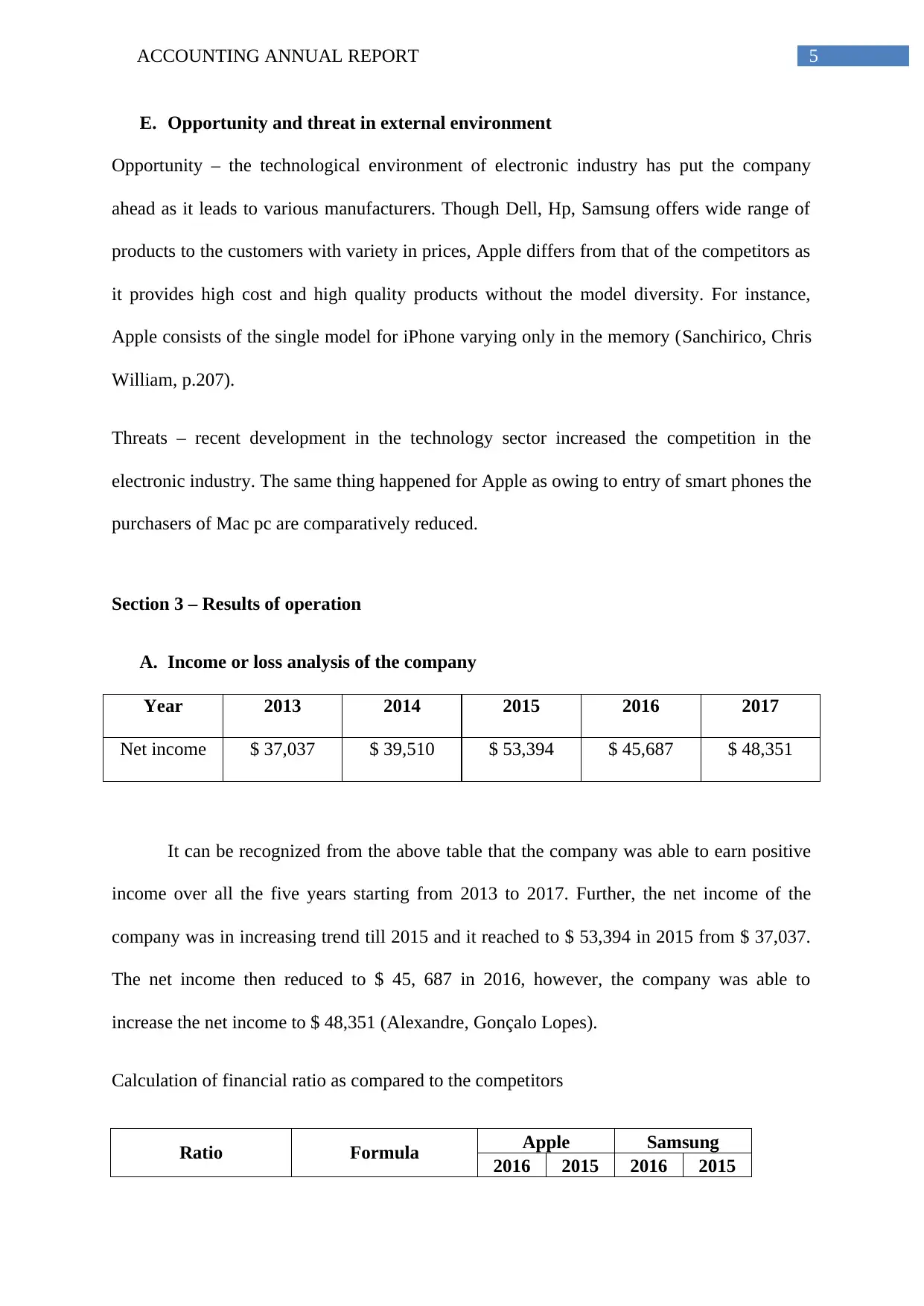
5ACCOUNTING ANNUAL REPORT
E. Opportunity and threat in external environment
Opportunity – the technological environment of electronic industry has put the company
ahead as it leads to various manufacturers. Though Dell, Hp, Samsung offers wide range of
products to the customers with variety in prices, Apple differs from that of the competitors as
it provides high cost and high quality products without the model diversity. For instance,
Apple consists of the single model for iPhone varying only in the memory (Sanchirico, Chris
William, p.207).
Threats – recent development in the technology sector increased the competition in the
electronic industry. The same thing happened for Apple as owing to entry of smart phones the
purchasers of Mac pc are comparatively reduced.
Section 3 – Results of operation
A. Income or loss analysis of the company
Year 2013 2014 2015 2016 2017
Net income $ 37,037 $ 39,510 $ 53,394 $ 45,687 $ 48,351
It can be recognized from the above table that the company was able to earn positive
income over all the five years starting from 2013 to 2017. Further, the net income of the
company was in increasing trend till 2015 and it reached to $ 53,394 in 2015 from $ 37,037.
The net income then reduced to $ 45, 687 in 2016, however, the company was able to
increase the net income to $ 48,351 (Alexandre, Gonçalo Lopes).
Calculation of financial ratio as compared to the competitors
Ratio Formula Apple Samsung
2016 2015 2016 2015
E. Opportunity and threat in external environment
Opportunity – the technological environment of electronic industry has put the company
ahead as it leads to various manufacturers. Though Dell, Hp, Samsung offers wide range of
products to the customers with variety in prices, Apple differs from that of the competitors as
it provides high cost and high quality products without the model diversity. For instance,
Apple consists of the single model for iPhone varying only in the memory (Sanchirico, Chris
William, p.207).
Threats – recent development in the technology sector increased the competition in the
electronic industry. The same thing happened for Apple as owing to entry of smart phones the
purchasers of Mac pc are comparatively reduced.
Section 3 – Results of operation
A. Income or loss analysis of the company
Year 2013 2014 2015 2016 2017
Net income $ 37,037 $ 39,510 $ 53,394 $ 45,687 $ 48,351
It can be recognized from the above table that the company was able to earn positive
income over all the five years starting from 2013 to 2017. Further, the net income of the
company was in increasing trend till 2015 and it reached to $ 53,394 in 2015 from $ 37,037.
The net income then reduced to $ 45, 687 in 2016, however, the company was able to
increase the net income to $ 48,351 (Alexandre, Gonçalo Lopes).
Calculation of financial ratio as compared to the competitors
Ratio Formula Apple Samsung
2016 2015 2016 2015
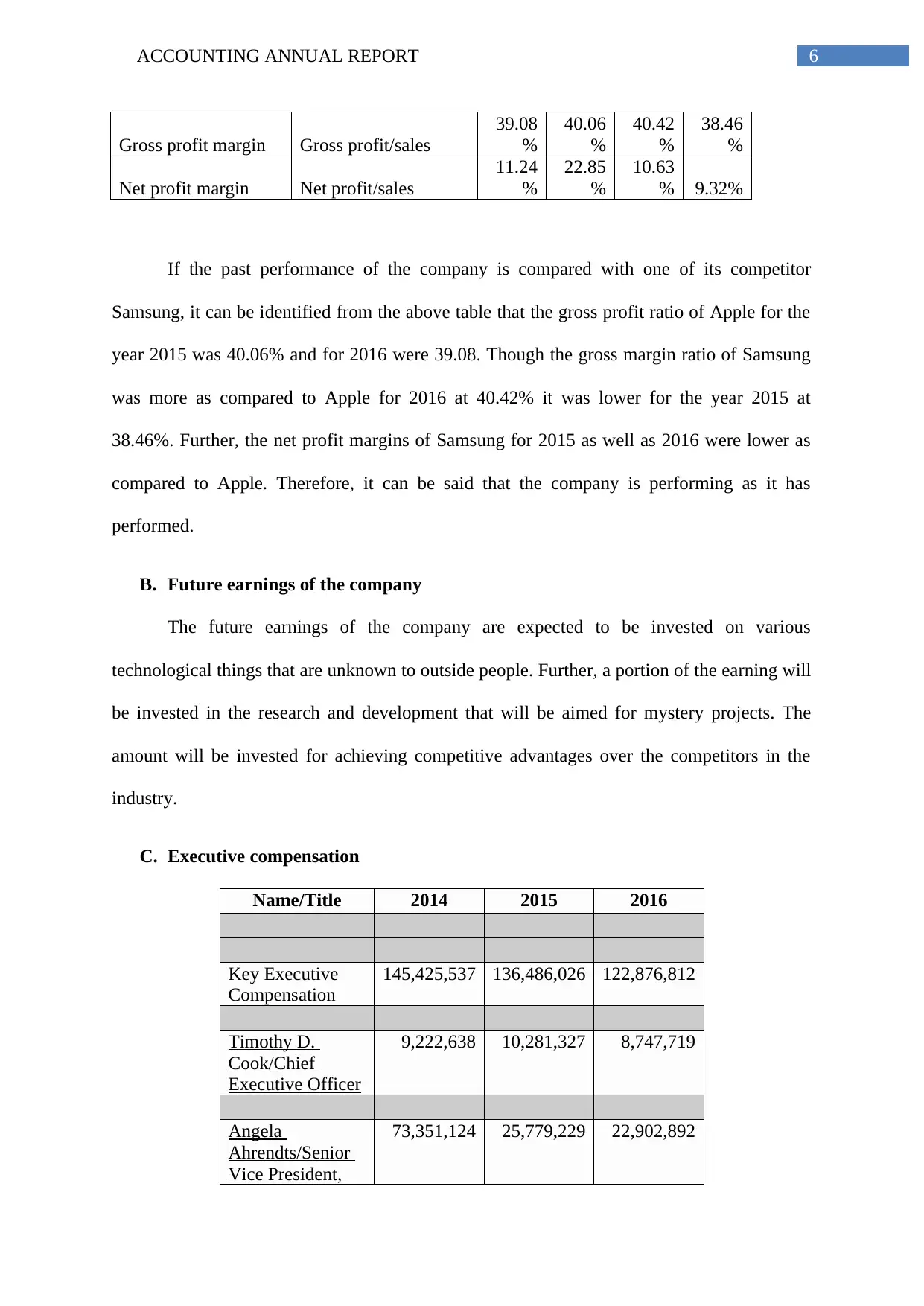
6ACCOUNTING ANNUAL REPORT
Gross profit margin Gross profit/sales
39.08
%
40.06
%
40.42
%
38.46
%
Net profit margin Net profit/sales
11.24
%
22.85
%
10.63
% 9.32%
If the past performance of the company is compared with one of its competitor
Samsung, it can be identified from the above table that the gross profit ratio of Apple for the
year 2015 was 40.06% and for 2016 were 39.08. Though the gross margin ratio of Samsung
was more as compared to Apple for 2016 at 40.42% it was lower for the year 2015 at
38.46%. Further, the net profit margins of Samsung for 2015 as well as 2016 were lower as
compared to Apple. Therefore, it can be said that the company is performing as it has
performed.
B. Future earnings of the company
The future earnings of the company are expected to be invested on various
technological things that are unknown to outside people. Further, a portion of the earning will
be invested in the research and development that will be aimed for mystery projects. The
amount will be invested for achieving competitive advantages over the competitors in the
industry.
C. Executive compensation
Name/Title 2014 2015 2016
Key Executive
Compensation
145,425,537 136,486,026 122,876,812
Timothy D.
Cook/Chief
Executive Officer
9,222,638 10,281,327 8,747,719
Angela
Ahrendts/Senior
Vice President,
73,351,124 25,779,229 22,902,892
Gross profit margin Gross profit/sales
39.08
%
40.06
%
40.42
%
38.46
%
Net profit margin Net profit/sales
11.24
%
22.85
%
10.63
% 9.32%
If the past performance of the company is compared with one of its competitor
Samsung, it can be identified from the above table that the gross profit ratio of Apple for the
year 2015 was 40.06% and for 2016 were 39.08. Though the gross margin ratio of Samsung
was more as compared to Apple for 2016 at 40.42% it was lower for the year 2015 at
38.46%. Further, the net profit margins of Samsung for 2015 as well as 2016 were lower as
compared to Apple. Therefore, it can be said that the company is performing as it has
performed.
B. Future earnings of the company
The future earnings of the company are expected to be invested on various
technological things that are unknown to outside people. Further, a portion of the earning will
be invested in the research and development that will be aimed for mystery projects. The
amount will be invested for achieving competitive advantages over the competitors in the
industry.
C. Executive compensation
Name/Title 2014 2015 2016
Key Executive
Compensation
145,425,537 136,486,026 122,876,812
Timothy D.
Cook/Chief
Executive Officer
9,222,638 10,281,327 8,747,719
Angela
Ahrendts/Senior
Vice President,
73,351,124 25,779,229 22,902,892
Paraphrase This Document
Need a fresh take? Get an instant paraphrase of this document with our AI Paraphraser
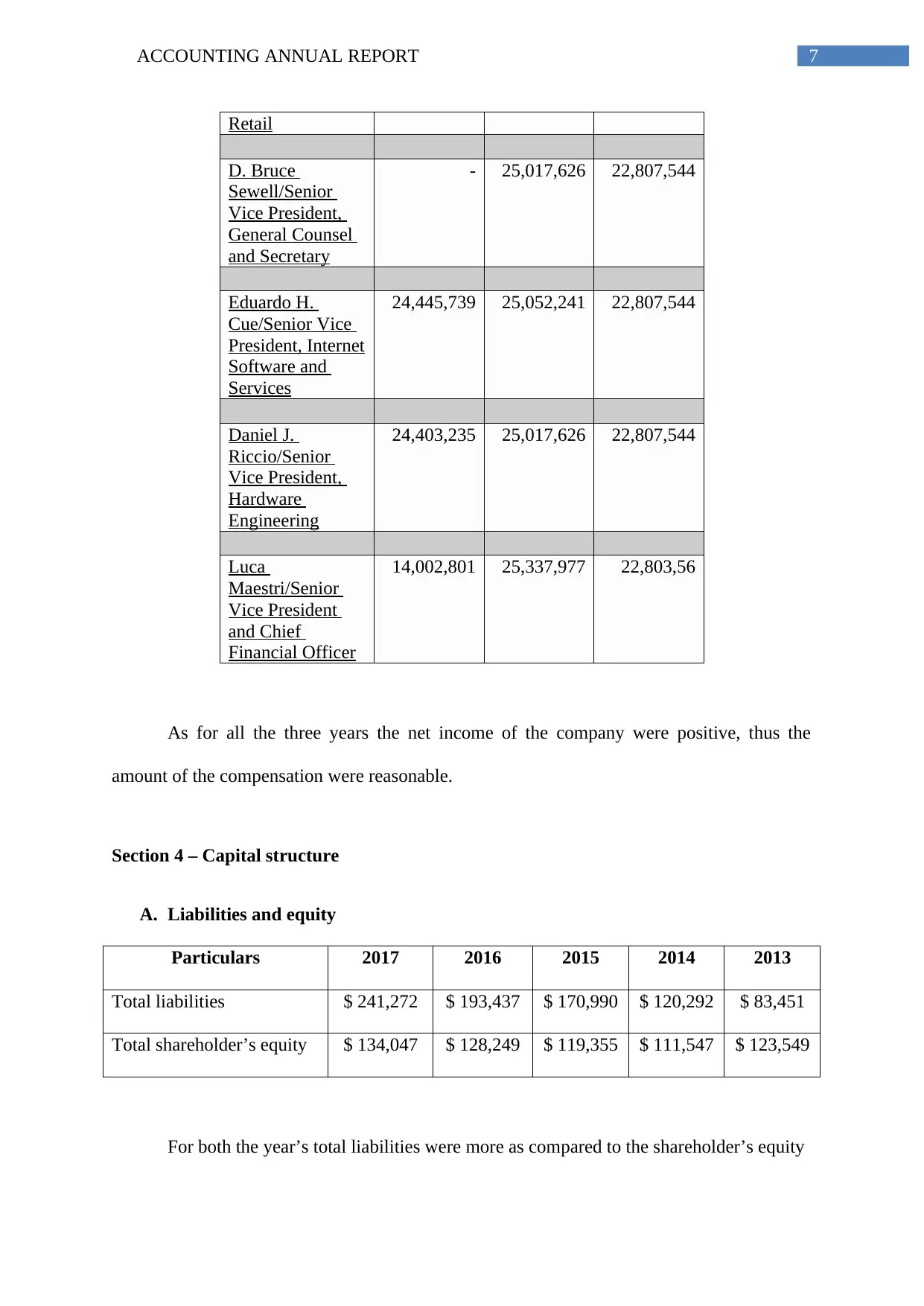
7ACCOUNTING ANNUAL REPORT
Retail
D. Bruce
Sewell/Senior
Vice President,
General Counsel
and Secretary
- 25,017,626 22,807,544
Eduardo H.
Cue/Senior Vice
President, Internet
Software and
Services
24,445,739 25,052,241 22,807,544
Daniel J.
Riccio/Senior
Vice President,
Hardware
Engineering
24,403,235 25,017,626 22,807,544
Luca
Maestri/Senior
Vice President
and Chief
Financial Officer
14,002,801 25,337,977 22,803,56
As for all the three years the net income of the company were positive, thus the
amount of the compensation were reasonable.
Section 4 – Capital structure
A. Liabilities and equity
Particulars 2017 2016 2015 2014 2013
Total liabilities $ 241,272 $ 193,437 $ 170,990 $ 120,292 $ 83,451
Total shareholder’s equity $ 134,047 $ 128,249 $ 119,355 $ 111,547 $ 123,549
For both the year’s total liabilities were more as compared to the shareholder’s equity
Retail
D. Bruce
Sewell/Senior
Vice President,
General Counsel
and Secretary
- 25,017,626 22,807,544
Eduardo H.
Cue/Senior Vice
President, Internet
Software and
Services
24,445,739 25,052,241 22,807,544
Daniel J.
Riccio/Senior
Vice President,
Hardware
Engineering
24,403,235 25,017,626 22,807,544
Luca
Maestri/Senior
Vice President
and Chief
Financial Officer
14,002,801 25,337,977 22,803,56
As for all the three years the net income of the company were positive, thus the
amount of the compensation were reasonable.
Section 4 – Capital structure
A. Liabilities and equity
Particulars 2017 2016 2015 2014 2013
Total liabilities $ 241,272 $ 193,437 $ 170,990 $ 120,292 $ 83,451
Total shareholder’s equity $ 134,047 $ 128,249 $ 119,355 $ 111,547 $ 123,549
For both the year’s total liabilities were more as compared to the shareholder’s equity
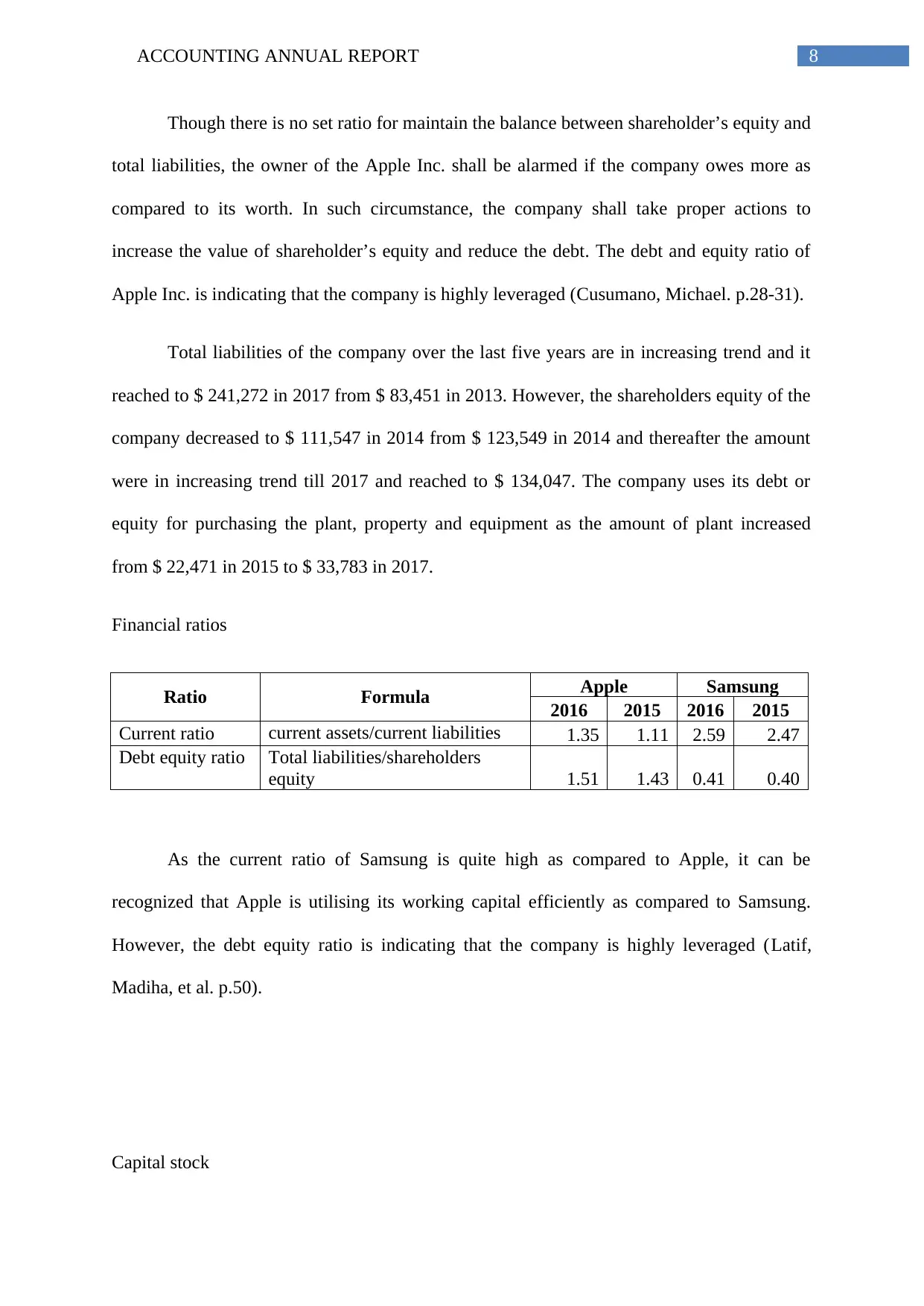
8ACCOUNTING ANNUAL REPORT
Though there is no set ratio for maintain the balance between shareholder’s equity and
total liabilities, the owner of the Apple Inc. shall be alarmed if the company owes more as
compared to its worth. In such circumstance, the company shall take proper actions to
increase the value of shareholder’s equity and reduce the debt. The debt and equity ratio of
Apple Inc. is indicating that the company is highly leveraged (Cusumano, Michael. p.28-31).
Total liabilities of the company over the last five years are in increasing trend and it
reached to $ 241,272 in 2017 from $ 83,451 in 2013. However, the shareholders equity of the
company decreased to $ 111,547 in 2014 from $ 123,549 in 2014 and thereafter the amount
were in increasing trend till 2017 and reached to $ 134,047. The company uses its debt or
equity for purchasing the plant, property and equipment as the amount of plant increased
from $ 22,471 in 2015 to $ 33,783 in 2017.
Financial ratios
Ratio Formula Apple Samsung
2016 2015 2016 2015
Current ratio current assets/current liabilities 1.35 1.11 2.59 2.47
Debt equity ratio Total liabilities/shareholders
equity 1.51 1.43 0.41 0.40
As the current ratio of Samsung is quite high as compared to Apple, it can be
recognized that Apple is utilising its working capital efficiently as compared to Samsung.
However, the debt equity ratio is indicating that the company is highly leveraged (Latif,
Madiha, et al. p.50).
Capital stock
Though there is no set ratio for maintain the balance between shareholder’s equity and
total liabilities, the owner of the Apple Inc. shall be alarmed if the company owes more as
compared to its worth. In such circumstance, the company shall take proper actions to
increase the value of shareholder’s equity and reduce the debt. The debt and equity ratio of
Apple Inc. is indicating that the company is highly leveraged (Cusumano, Michael. p.28-31).
Total liabilities of the company over the last five years are in increasing trend and it
reached to $ 241,272 in 2017 from $ 83,451 in 2013. However, the shareholders equity of the
company decreased to $ 111,547 in 2014 from $ 123,549 in 2014 and thereafter the amount
were in increasing trend till 2017 and reached to $ 134,047. The company uses its debt or
equity for purchasing the plant, property and equipment as the amount of plant increased
from $ 22,471 in 2015 to $ 33,783 in 2017.
Financial ratios
Ratio Formula Apple Samsung
2016 2015 2016 2015
Current ratio current assets/current liabilities 1.35 1.11 2.59 2.47
Debt equity ratio Total liabilities/shareholders
equity 1.51 1.43 0.41 0.40
As the current ratio of Samsung is quite high as compared to Apple, it can be
recognized that Apple is utilising its working capital efficiently as compared to Samsung.
However, the debt equity ratio is indicating that the company is highly leveraged (Latif,
Madiha, et al. p.50).
Capital stock
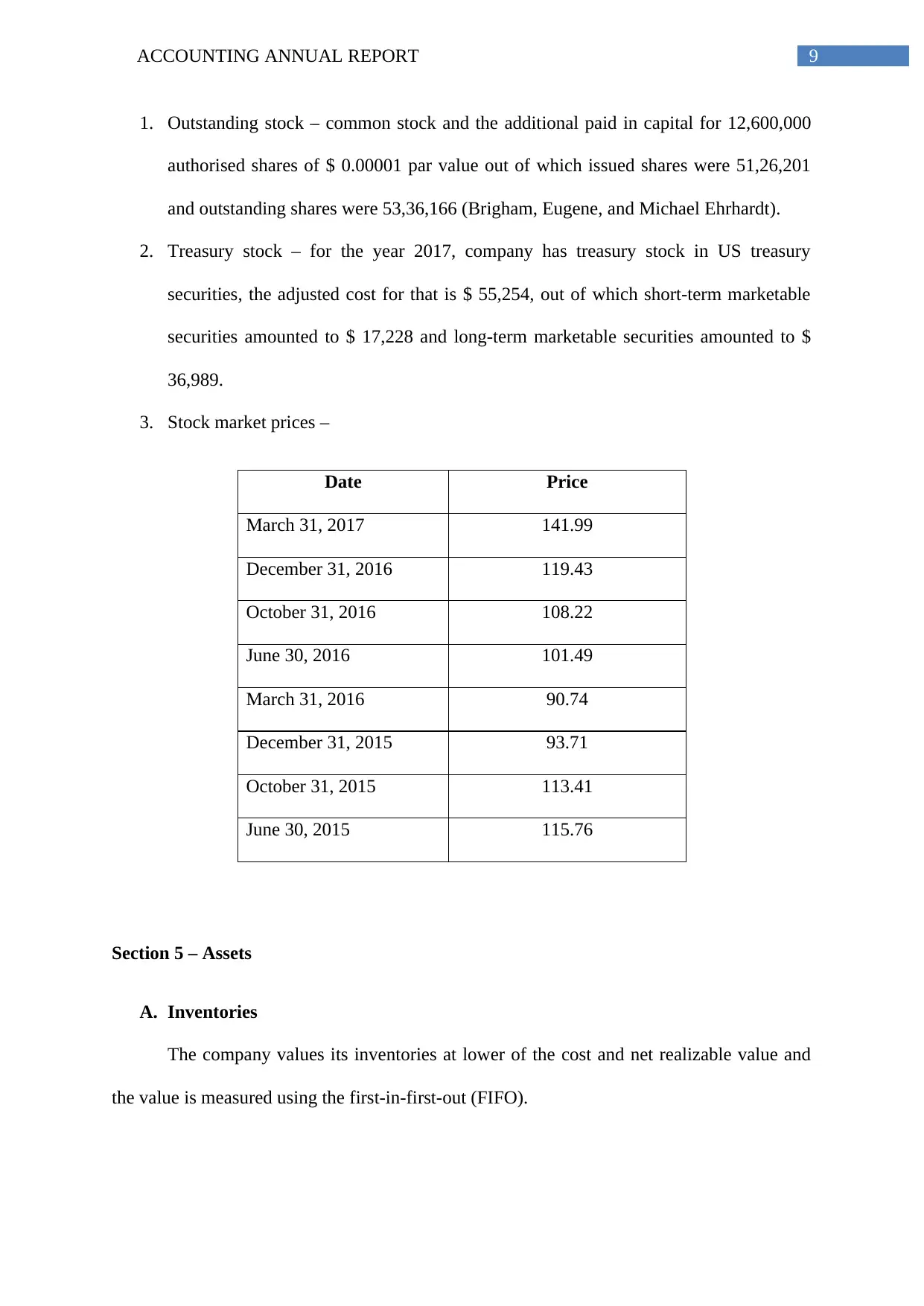
9ACCOUNTING ANNUAL REPORT
1. Outstanding stock – common stock and the additional paid in capital for 12,600,000
authorised shares of $ 0.00001 par value out of which issued shares were 51,26,201
and outstanding shares were 53,36,166 (Brigham, Eugene, and Michael Ehrhardt).
2. Treasury stock – for the year 2017, company has treasury stock in US treasury
securities, the adjusted cost for that is $ 55,254, out of which short-term marketable
securities amounted to $ 17,228 and long-term marketable securities amounted to $
36,989.
3. Stock market prices –
Date Price
March 31, 2017 141.99
December 31, 2016 119.43
October 31, 2016 108.22
June 30, 2016 101.49
March 31, 2016 90.74
December 31, 2015 93.71
October 31, 2015 113.41
June 30, 2015 115.76
Section 5 – Assets
A. Inventories
The company values its inventories at lower of the cost and net realizable value and
the value is measured using the first-in-first-out (FIFO).
1. Outstanding stock – common stock and the additional paid in capital for 12,600,000
authorised shares of $ 0.00001 par value out of which issued shares were 51,26,201
and outstanding shares were 53,36,166 (Brigham, Eugene, and Michael Ehrhardt).
2. Treasury stock – for the year 2017, company has treasury stock in US treasury
securities, the adjusted cost for that is $ 55,254, out of which short-term marketable
securities amounted to $ 17,228 and long-term marketable securities amounted to $
36,989.
3. Stock market prices –
Date Price
March 31, 2017 141.99
December 31, 2016 119.43
October 31, 2016 108.22
June 30, 2016 101.49
March 31, 2016 90.74
December 31, 2015 93.71
October 31, 2015 113.41
June 30, 2015 115.76
Section 5 – Assets
A. Inventories
The company values its inventories at lower of the cost and net realizable value and
the value is measured using the first-in-first-out (FIFO).
Secure Best Marks with AI Grader
Need help grading? Try our AI Grader for instant feedback on your assignments.

10ACCOUNTING ANNUAL REPORT
B. Depreciation on plant, property and equipment
Depreciation is calculated through using the straight-line method on the estimated
useful life of the assets.
C. Assets
Assets 2017 2016
Current assets $ 128,645 $ 106,869
Long-term assets $ 246,674 $ 214,817
As per the above table, the long term assets of the company are more as compared to
the current assets of the company for both the year.
In terms of long term assets the company is growing as the long term asset of the
company increased to $ 246,674 in 2017 from $ 214,817 in 2016.
The company had some major purchases during the year that were purchased through
debt.
Financial ratio
Ratio Formula Apple Samsung
2016 2015 2016 2015
Return on equity Net income/shareholder’s equity
36.90 46.25
12.4
9 11.17
Return on assets Net income/average total assets 14.93 20.45 8.89 7.91
It can be identified that both the ratios of Apple Inc for the year 2015 as well as 2016
is better as compared to Samsung.
B. Depreciation on plant, property and equipment
Depreciation is calculated through using the straight-line method on the estimated
useful life of the assets.
C. Assets
Assets 2017 2016
Current assets $ 128,645 $ 106,869
Long-term assets $ 246,674 $ 214,817
As per the above table, the long term assets of the company are more as compared to
the current assets of the company for both the year.
In terms of long term assets the company is growing as the long term asset of the
company increased to $ 246,674 in 2017 from $ 214,817 in 2016.
The company had some major purchases during the year that were purchased through
debt.
Financial ratio
Ratio Formula Apple Samsung
2016 2015 2016 2015
Return on equity Net income/shareholder’s equity
36.90 46.25
12.4
9 11.17
Return on assets Net income/average total assets 14.93 20.45 8.89 7.91
It can be identified that both the ratios of Apple Inc for the year 2015 as well as 2016
is better as compared to Samsung.
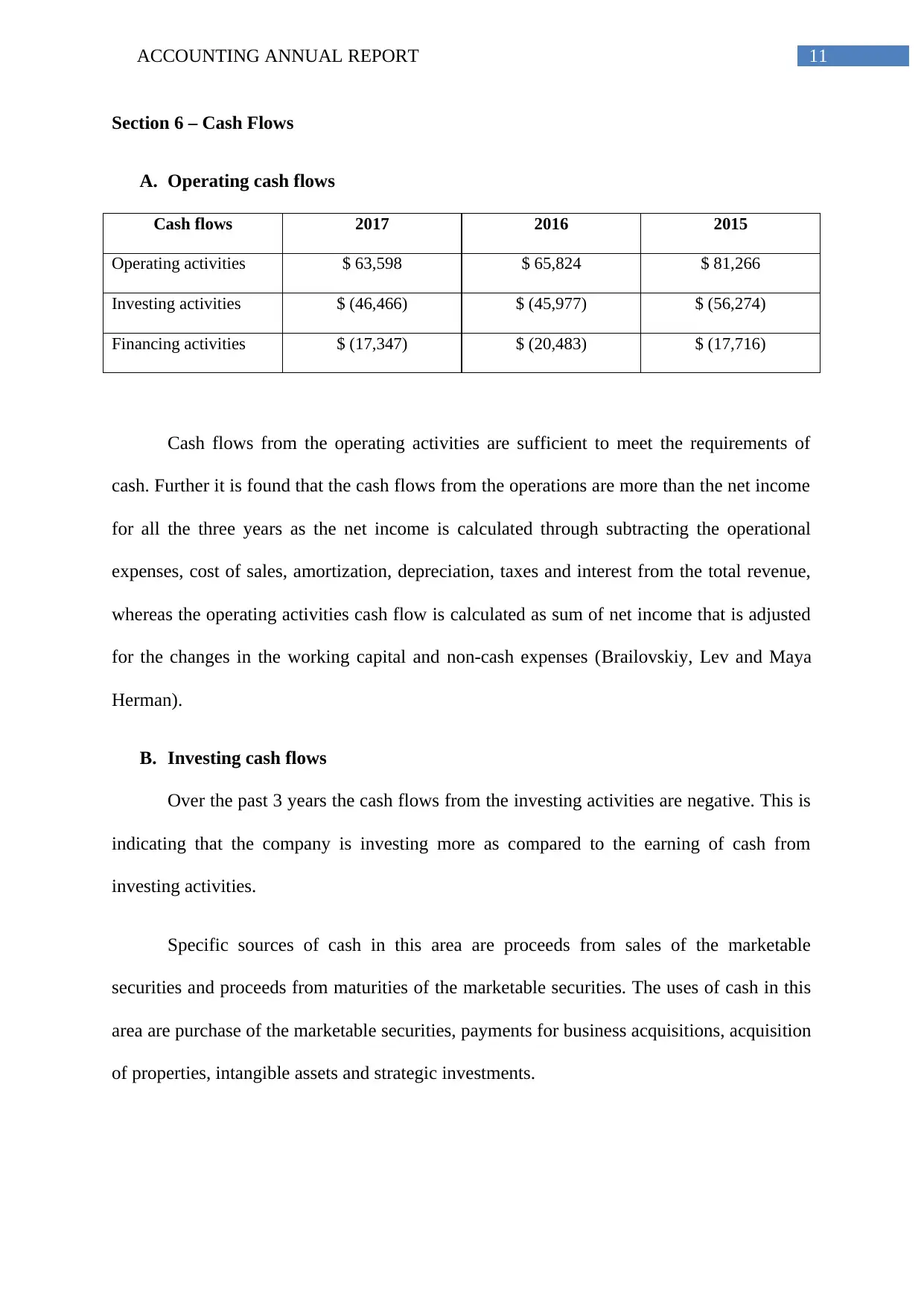
11ACCOUNTING ANNUAL REPORT
Section 6 – Cash Flows
A. Operating cash flows
Cash flows 2017 2016 2015
Operating activities $ 63,598 $ 65,824 $ 81,266
Investing activities $ (46,466) $ (45,977) $ (56,274)
Financing activities $ (17,347) $ (20,483) $ (17,716)
Cash flows from the operating activities are sufficient to meet the requirements of
cash. Further it is found that the cash flows from the operations are more than the net income
for all the three years as the net income is calculated through subtracting the operational
expenses, cost of sales, amortization, depreciation, taxes and interest from the total revenue,
whereas the operating activities cash flow is calculated as sum of net income that is adjusted
for the changes in the working capital and non-cash expenses (Brailovskiy, Lev and Maya
Herman).
B. Investing cash flows
Over the past 3 years the cash flows from the investing activities are negative. This is
indicating that the company is investing more as compared to the earning of cash from
investing activities.
Specific sources of cash in this area are proceeds from sales of the marketable
securities and proceeds from maturities of the marketable securities. The uses of cash in this
area are purchase of the marketable securities, payments for business acquisitions, acquisition
of properties, intangible assets and strategic investments.
Section 6 – Cash Flows
A. Operating cash flows
Cash flows 2017 2016 2015
Operating activities $ 63,598 $ 65,824 $ 81,266
Investing activities $ (46,466) $ (45,977) $ (56,274)
Financing activities $ (17,347) $ (20,483) $ (17,716)
Cash flows from the operating activities are sufficient to meet the requirements of
cash. Further it is found that the cash flows from the operations are more than the net income
for all the three years as the net income is calculated through subtracting the operational
expenses, cost of sales, amortization, depreciation, taxes and interest from the total revenue,
whereas the operating activities cash flow is calculated as sum of net income that is adjusted
for the changes in the working capital and non-cash expenses (Brailovskiy, Lev and Maya
Herman).
B. Investing cash flows
Over the past 3 years the cash flows from the investing activities are negative. This is
indicating that the company is investing more as compared to the earning of cash from
investing activities.
Specific sources of cash in this area are proceeds from sales of the marketable
securities and proceeds from maturities of the marketable securities. The uses of cash in this
area are purchase of the marketable securities, payments for business acquisitions, acquisition
of properties, intangible assets and strategic investments.
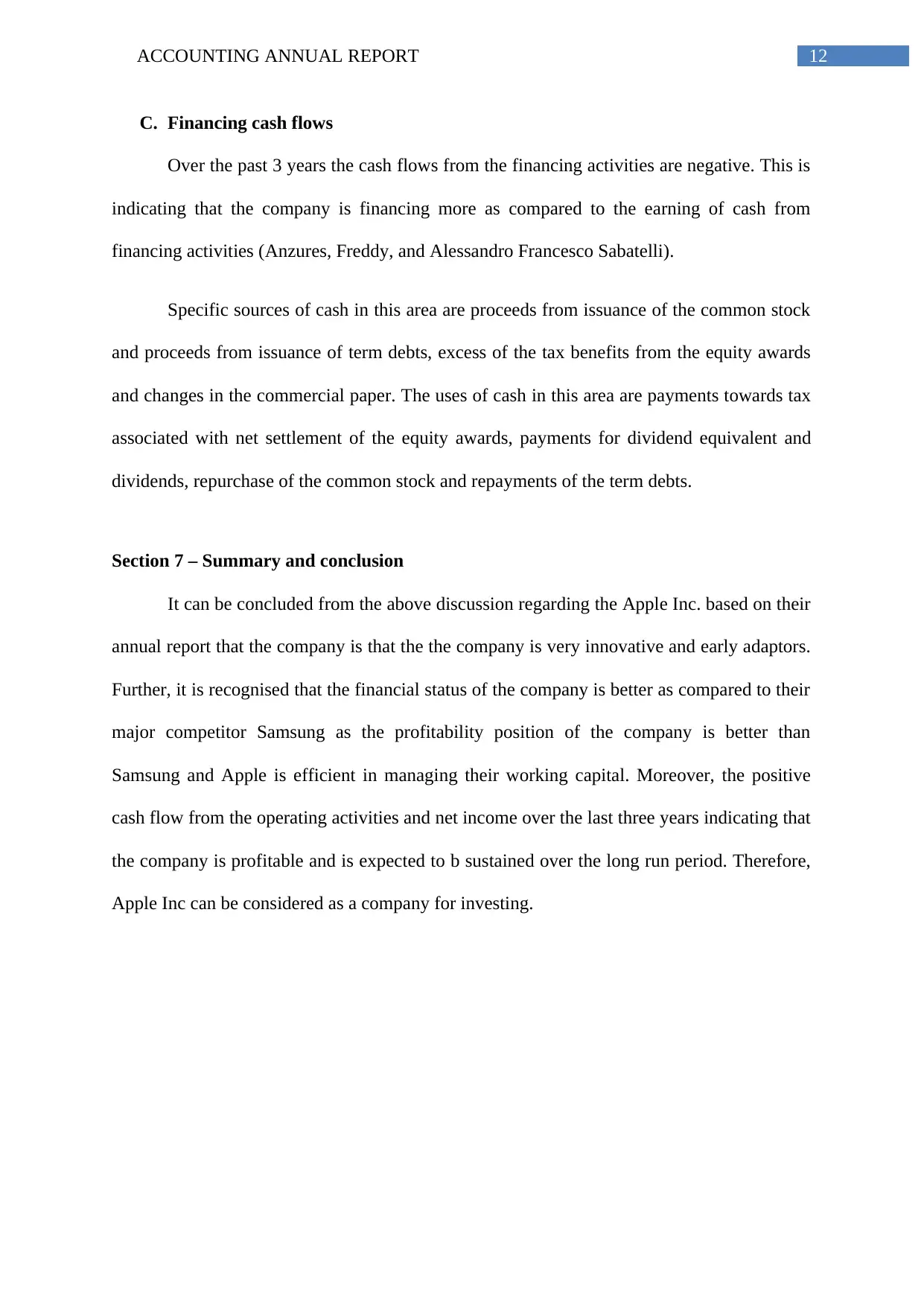
12ACCOUNTING ANNUAL REPORT
C. Financing cash flows
Over the past 3 years the cash flows from the financing activities are negative. This is
indicating that the company is financing more as compared to the earning of cash from
financing activities (Anzures, Freddy, and Alessandro Francesco Sabatelli).
Specific sources of cash in this area are proceeds from issuance of the common stock
and proceeds from issuance of term debts, excess of the tax benefits from the equity awards
and changes in the commercial paper. The uses of cash in this area are payments towards tax
associated with net settlement of the equity awards, payments for dividend equivalent and
dividends, repurchase of the common stock and repayments of the term debts.
Section 7 – Summary and conclusion
It can be concluded from the above discussion regarding the Apple Inc. based on their
annual report that the company is that the the company is very innovative and early adaptors.
Further, it is recognised that the financial status of the company is better as compared to their
major competitor Samsung as the profitability position of the company is better than
Samsung and Apple is efficient in managing their working capital. Moreover, the positive
cash flow from the operating activities and net income over the last three years indicating that
the company is profitable and is expected to b sustained over the long run period. Therefore,
Apple Inc can be considered as a company for investing.
C. Financing cash flows
Over the past 3 years the cash flows from the financing activities are negative. This is
indicating that the company is financing more as compared to the earning of cash from
financing activities (Anzures, Freddy, and Alessandro Francesco Sabatelli).
Specific sources of cash in this area are proceeds from issuance of the common stock
and proceeds from issuance of term debts, excess of the tax benefits from the equity awards
and changes in the commercial paper. The uses of cash in this area are payments towards tax
associated with net settlement of the equity awards, payments for dividend equivalent and
dividends, repurchase of the common stock and repayments of the term debts.
Section 7 – Summary and conclusion
It can be concluded from the above discussion regarding the Apple Inc. based on their
annual report that the company is that the the company is very innovative and early adaptors.
Further, it is recognised that the financial status of the company is better as compared to their
major competitor Samsung as the profitability position of the company is better than
Samsung and Apple is efficient in managing their working capital. Moreover, the positive
cash flow from the operating activities and net income over the last three years indicating that
the company is profitable and is expected to b sustained over the long run period. Therefore,
Apple Inc can be considered as a company for investing.
Paraphrase This Document
Need a fresh take? Get an instant paraphrase of this document with our AI Paraphraser
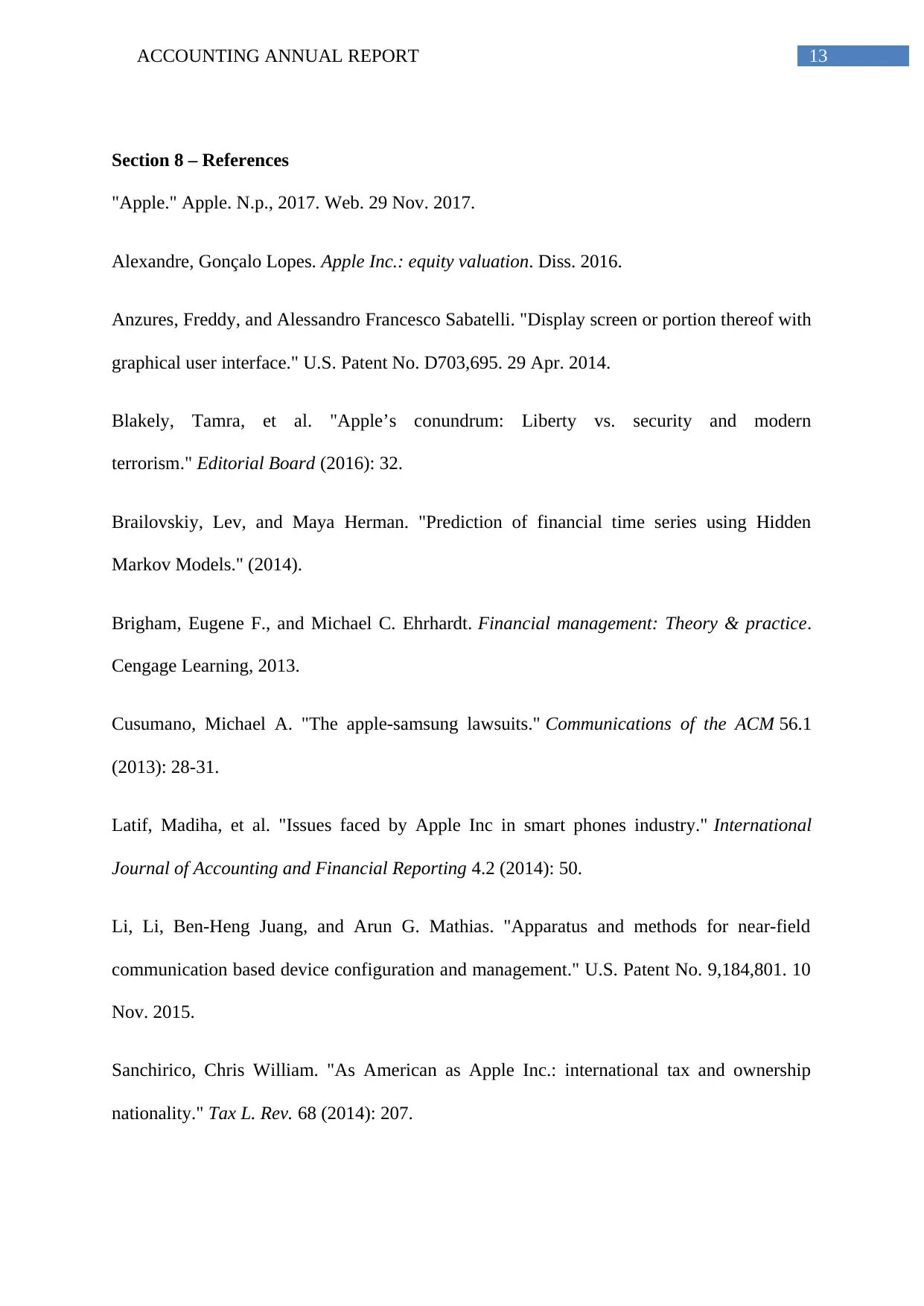
13ACCOUNTING ANNUAL REPORT
Section 8 – References
"Apple." Apple. N.p., 2017. Web. 29 Nov. 2017.
Alexandre, Gonçalo Lopes. Apple Inc.: equity valuation. Diss. 2016.
Anzures, Freddy, and Alessandro Francesco Sabatelli. "Display screen or portion thereof with
graphical user interface." U.S. Patent No. D703,695. 29 Apr. 2014.
Blakely, Tamra, et al. "Apple’s conundrum: Liberty vs. security and modern
terrorism." Editorial Board (2016): 32.
Brailovskiy, Lev, and Maya Herman. "Prediction of financial time series using Hidden
Markov Models." (2014).
Brigham, Eugene F., and Michael C. Ehrhardt. Financial management: Theory & practice.
Cengage Learning, 2013.
Cusumano, Michael A. "The apple-samsung lawsuits." Communications of the ACM 56.1
(2013): 28-31.
Latif, Madiha, et al. "Issues faced by Apple Inc in smart phones industry." International
Journal of Accounting and Financial Reporting 4.2 (2014): 50.
Li, Li, Ben-Heng Juang, and Arun G. Mathias. "Apparatus and methods for near-field
communication based device configuration and management." U.S. Patent No. 9,184,801. 10
Nov. 2015.
Sanchirico, Chris William. "As American as Apple Inc.: international tax and ownership
nationality." Tax L. Rev. 68 (2014): 207.
Section 8 – References
"Apple." Apple. N.p., 2017. Web. 29 Nov. 2017.
Alexandre, Gonçalo Lopes. Apple Inc.: equity valuation. Diss. 2016.
Anzures, Freddy, and Alessandro Francesco Sabatelli. "Display screen or portion thereof with
graphical user interface." U.S. Patent No. D703,695. 29 Apr. 2014.
Blakely, Tamra, et al. "Apple’s conundrum: Liberty vs. security and modern
terrorism." Editorial Board (2016): 32.
Brailovskiy, Lev, and Maya Herman. "Prediction of financial time series using Hidden
Markov Models." (2014).
Brigham, Eugene F., and Michael C. Ehrhardt. Financial management: Theory & practice.
Cengage Learning, 2013.
Cusumano, Michael A. "The apple-samsung lawsuits." Communications of the ACM 56.1
(2013): 28-31.
Latif, Madiha, et al. "Issues faced by Apple Inc in smart phones industry." International
Journal of Accounting and Financial Reporting 4.2 (2014): 50.
Li, Li, Ben-Heng Juang, and Arun G. Mathias. "Apparatus and methods for near-field
communication based device configuration and management." U.S. Patent No. 9,184,801. 10
Nov. 2015.
Sanchirico, Chris William. "As American as Apple Inc.: international tax and ownership
nationality." Tax L. Rev. 68 (2014): 207.
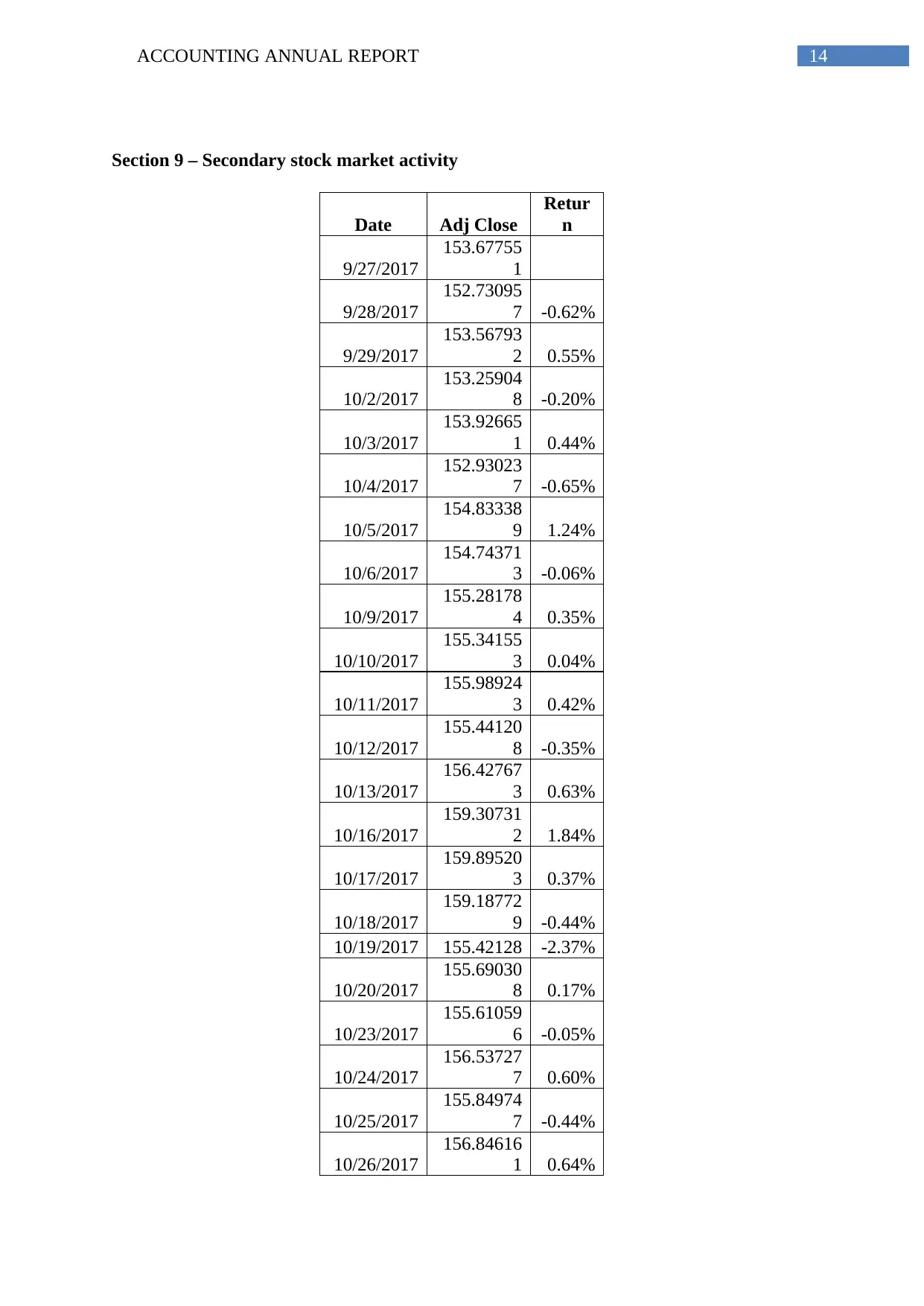
14ACCOUNTING ANNUAL REPORT
Section 9 – Secondary stock market activity
Date Adj Close
Retur
n
9/27/2017
153.67755
1
9/28/2017
152.73095
7 -0.62%
9/29/2017
153.56793
2 0.55%
10/2/2017
153.25904
8 -0.20%
10/3/2017
153.92665
1 0.44%
10/4/2017
152.93023
7 -0.65%
10/5/2017
154.83338
9 1.24%
10/6/2017
154.74371
3 -0.06%
10/9/2017
155.28178
4 0.35%
10/10/2017
155.34155
3 0.04%
10/11/2017
155.98924
3 0.42%
10/12/2017
155.44120
8 -0.35%
10/13/2017
156.42767
3 0.63%
10/16/2017
159.30731
2 1.84%
10/17/2017
159.89520
3 0.37%
10/18/2017
159.18772
9 -0.44%
10/19/2017 155.42128 -2.37%
10/20/2017
155.69030
8 0.17%
10/23/2017
155.61059
6 -0.05%
10/24/2017
156.53727
7 0.60%
10/25/2017
155.84974
7 -0.44%
10/26/2017
156.84616
1 0.64%
Section 9 – Secondary stock market activity
Date Adj Close
Retur
n
9/27/2017
153.67755
1
9/28/2017
152.73095
7 -0.62%
9/29/2017
153.56793
2 0.55%
10/2/2017
153.25904
8 -0.20%
10/3/2017
153.92665
1 0.44%
10/4/2017
152.93023
7 -0.65%
10/5/2017
154.83338
9 1.24%
10/6/2017
154.74371
3 -0.06%
10/9/2017
155.28178
4 0.35%
10/10/2017
155.34155
3 0.04%
10/11/2017
155.98924
3 0.42%
10/12/2017
155.44120
8 -0.35%
10/13/2017
156.42767
3 0.63%
10/16/2017
159.30731
2 1.84%
10/17/2017
159.89520
3 0.37%
10/18/2017
159.18772
9 -0.44%
10/19/2017 155.42128 -2.37%
10/20/2017
155.69030
8 0.17%
10/23/2017
155.61059
6 -0.05%
10/24/2017
156.53727
7 0.60%
10/25/2017
155.84974
7 -0.44%
10/26/2017
156.84616
1 0.64%
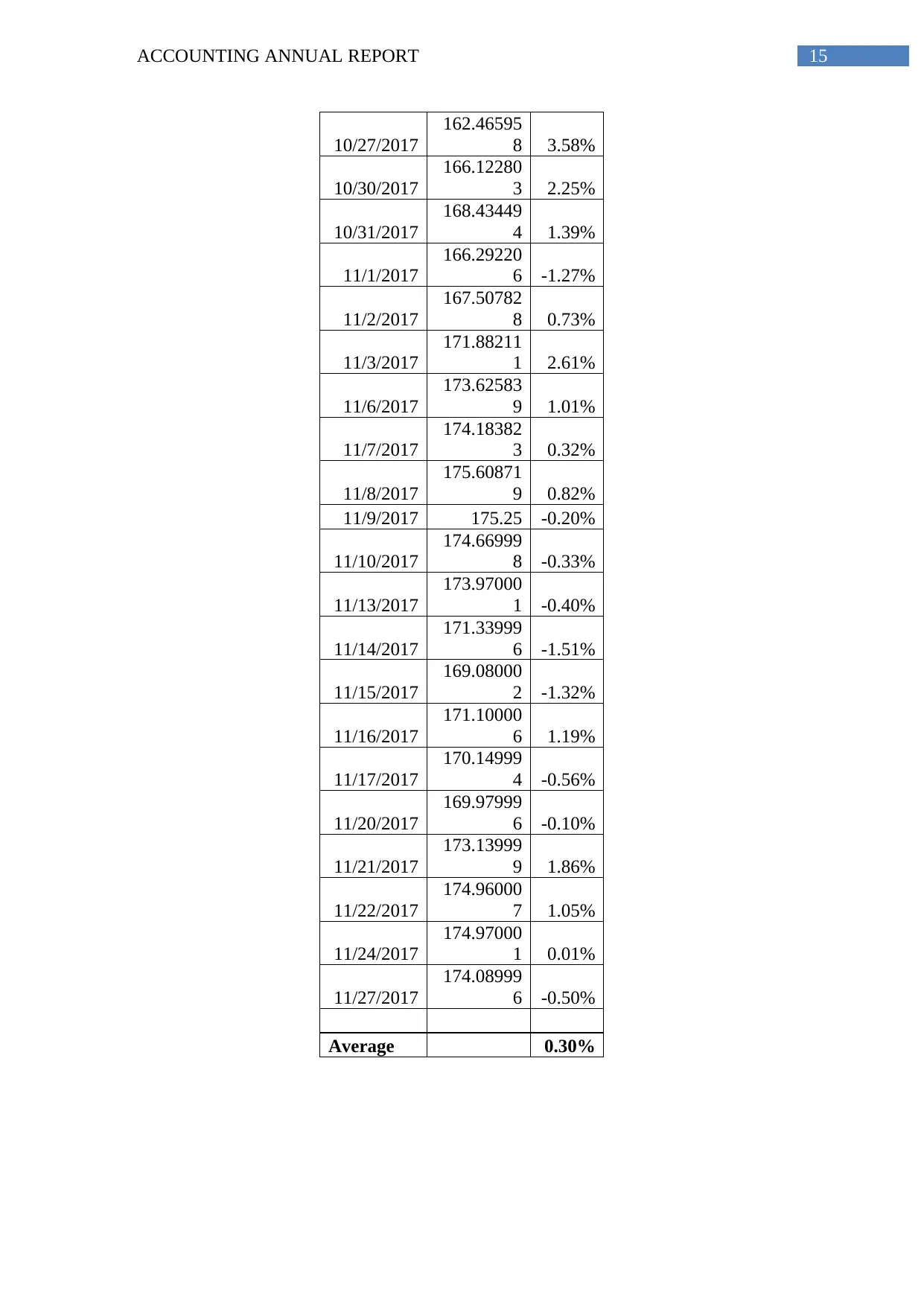
15ACCOUNTING ANNUAL REPORT
10/27/2017
162.46595
8 3.58%
10/30/2017
166.12280
3 2.25%
10/31/2017
168.43449
4 1.39%
11/1/2017
166.29220
6 -1.27%
11/2/2017
167.50782
8 0.73%
11/3/2017
171.88211
1 2.61%
11/6/2017
173.62583
9 1.01%
11/7/2017
174.18382
3 0.32%
11/8/2017
175.60871
9 0.82%
11/9/2017 175.25 -0.20%
11/10/2017
174.66999
8 -0.33%
11/13/2017
173.97000
1 -0.40%
11/14/2017
171.33999
6 -1.51%
11/15/2017
169.08000
2 -1.32%
11/16/2017
171.10000
6 1.19%
11/17/2017
170.14999
4 -0.56%
11/20/2017
169.97999
6 -0.10%
11/21/2017
173.13999
9 1.86%
11/22/2017
174.96000
7 1.05%
11/24/2017
174.97000
1 0.01%
11/27/2017
174.08999
6 -0.50%
Average 0.30%
10/27/2017
162.46595
8 3.58%
10/30/2017
166.12280
3 2.25%
10/31/2017
168.43449
4 1.39%
11/1/2017
166.29220
6 -1.27%
11/2/2017
167.50782
8 0.73%
11/3/2017
171.88211
1 2.61%
11/6/2017
173.62583
9 1.01%
11/7/2017
174.18382
3 0.32%
11/8/2017
175.60871
9 0.82%
11/9/2017 175.25 -0.20%
11/10/2017
174.66999
8 -0.33%
11/13/2017
173.97000
1 -0.40%
11/14/2017
171.33999
6 -1.51%
11/15/2017
169.08000
2 -1.32%
11/16/2017
171.10000
6 1.19%
11/17/2017
170.14999
4 -0.56%
11/20/2017
169.97999
6 -0.10%
11/21/2017
173.13999
9 1.86%
11/22/2017
174.96000
7 1.05%
11/24/2017
174.97000
1 0.01%
11/27/2017
174.08999
6 -0.50%
Average 0.30%
Secure Best Marks with AI Grader
Need help grading? Try our AI Grader for instant feedback on your assignments.
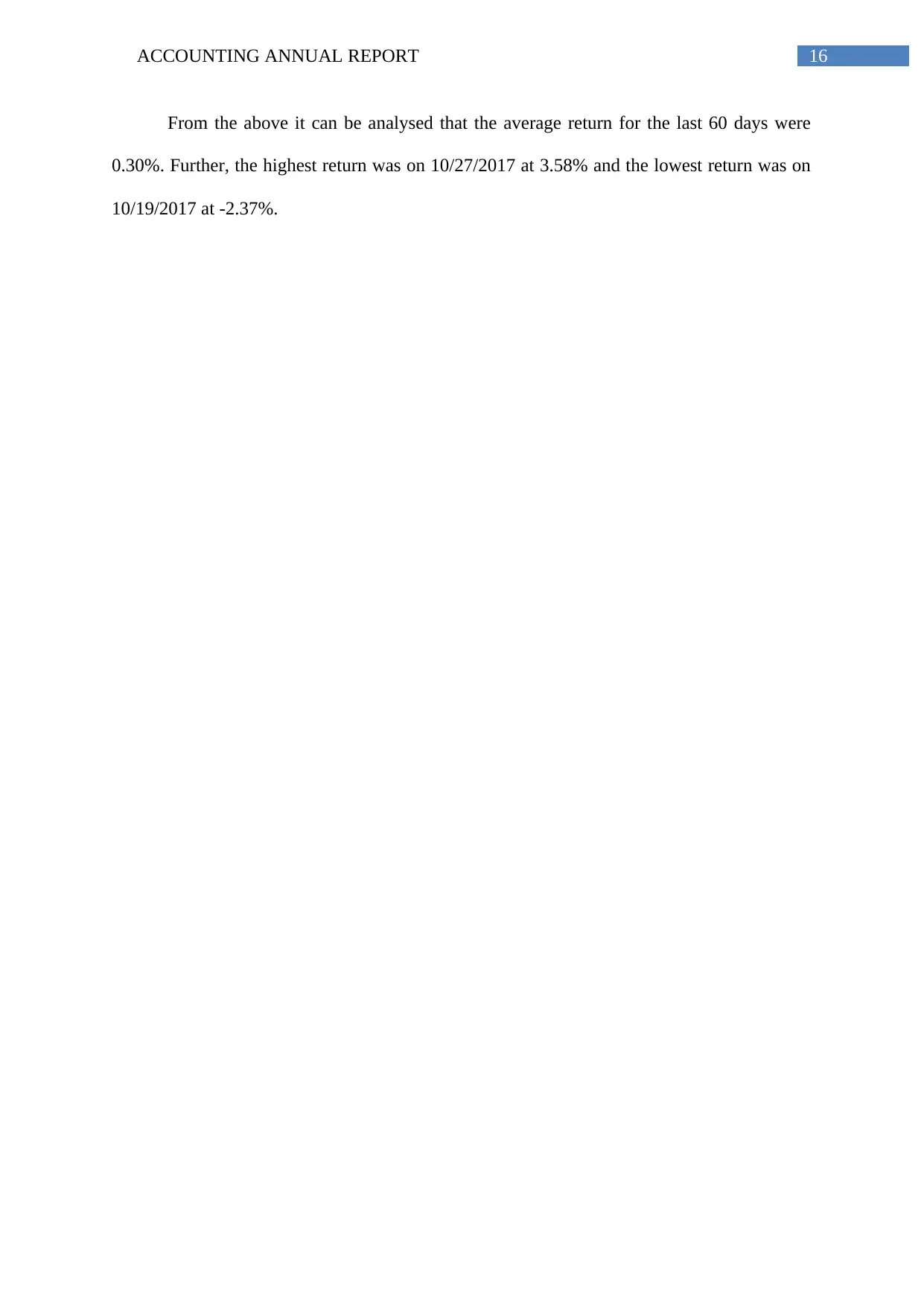
16ACCOUNTING ANNUAL REPORT
From the above it can be analysed that the average return for the last 60 days were
0.30%. Further, the highest return was on 10/27/2017 at 3.58% and the lowest return was on
10/19/2017 at -2.37%.
From the above it can be analysed that the average return for the last 60 days were
0.30%. Further, the highest return was on 10/27/2017 at 3.58% and the lowest return was on
10/19/2017 at -2.37%.
1 out of 17
Related Documents
Your All-in-One AI-Powered Toolkit for Academic Success.
+13062052269
info@desklib.com
Available 24*7 on WhatsApp / Email
![[object Object]](/_next/static/media/star-bottom.7253800d.svg)
Unlock your academic potential
© 2024 | Zucol Services PVT LTD | All rights reserved.





